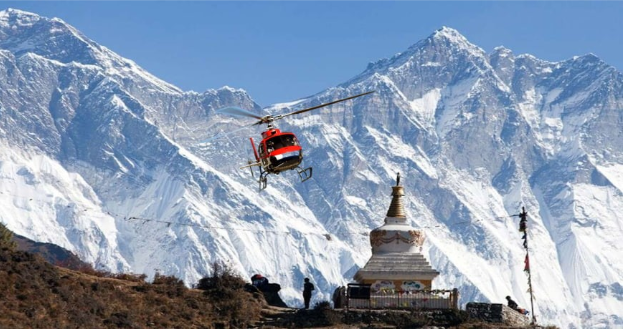An Everest helicopter tour is one of the most spectacular and luxurious ways to experience the grandeur of the Himalayas. In just a few hours, you can witness the towering peaks of Mount Everest, Lhotse, Nuptse, and Ama Dablam without enduring the days-long trek. While the panoramic views and high-altitude landings are thrilling, many travelers rightly ask: Is the Everest helicopter tour safe?
This article provides a comprehensive look into the safety measures, risks, protocols, and precautions surrounding helicopter tours to Everest. Whether you are planning to take the trip yourself or simply researching for future travel, understanding the Everest helicopter tour safety standards will give you peace of mind.
What is the Everest Helicopter Tour?
The Everest helicopter tour is a high-altitude flight from Kathmandu or Lukla to the Everest region, typically including a flyover of Everest Base Camp and a landing at Kala Patthar (5,545 meters), a renowned viewpoint of Mount Everest. The tour often includes a brief stop at Hotel Everest View for breakfast.
Duration: 4–5 hours total
Maximum Altitude: 5,545 meters (Kala Patthar)
Is the Everest Helicopter Tour Safe?
In short — yes, the Everest helicopter tour is generally safe, provided you book with a licensed, reputable operator who adheres to Civil Aviation Authority of Nepal (CAAN) safety protocols. But like any high-altitude or aviation-based adventure, it does come with inherent risks that must be managed.
Key Safety Measures in Everest Helicopter Tours
1. Modern, High-Performance Helicopters
Most operators use Airbus AS350 B3e helicopters or equivalent models specifically designed for high-altitude performance. These helicopters are:
- Engineered for thin-air environments
- Equipped with advanced avionics and GPS systems
- Maintained under strict schedules
2. Experienced, Certified Pilots
A vital aspect of safety is the pilot’s skill and experience. Everest region pilots are trained to fly in extreme altitudes, unpredictable weather, and mountainous terrain. Their knowledge of local air currents and emergency protocols is crucial for safe operation.
3. Weather Monitoring & Flight Planning
Flights are only scheduled after confirming stable weather using advanced forecasting systems. Operators monitor:
- Wind speed and direction
- Cloud cover
- Visibility
- Precipitation and turbulence
If the weather is unstable, flights are postponed or rescheduled, ensuring maximum safety.
4. Weight Management
Due to altitude and air density restrictions, helicopters follow strict weight limits. Typically:
- A helicopter carries 4–5 passengers
- If landing at Kala Patthar, only 3 passengers at a time may be allowed due to thin air
- Baggage is minimal — only essentials are permitted
5. Oxygen Supply Onboard
Since helicopters ascend quickly to over 5,000 meters, operators equip flights with emergency oxygen systems. Pilots are trained to recognize and respond to Acute Mountain Sickness (AMS) symptoms.
6. Emergency Protocols
Every flight follows a pre-set emergency response system. In case of weather disturbances, engine issues, or medical emergencies, helicopters have:
- Emergency landing procedures
- Radio contact with Kathmandu ATC
- Standby rescue units in Lukla or Kathmandu
Risks to Consider and How They’re Handled
1. Altitude Sickness (AMS)
Ascending rapidly to 5,500 meters can expose passengers to AMS. Symptoms may include:
- Dizziness
- Shortness of breath
- Headache
- Nausea
Mitigation:
- Limit time at Kala Patthar to 5–10 minutes
- Optional oxygen cylinders onboard
- Land at lower altitudes (Pheriche or Hotel Everest View) if needed
2. Weather Volatility
Mountain weather can change in minutes. Strong winds, clouds, or storms can disrupt visibility.
Mitigation:
- Early morning flights are scheduled to avoid afternoon turbulence
- Pilots receive hourly updates and reroute if needed
- Rescheduling is free or partially refundable with reputable operators
3. Mechanical Issues
Helicopter malfunctions are rare but possible. All aircraft must pass CAAN inspections and follow global aviation standards.
Mitigation:
- Daily technical checks
- Use of certified Airbus aircraft
- Scheduled maintenance and flight hour tracking
Choosing a Safe Tour Operator
Not all tour operators offer the same safety standards. Here’s what to look for:
| Criteria | What to Check |
| License | Ensure the operator is registered with CAAN |
| Pilot Credentials | Ask for experience details and high-altitude certification |
| Aircraft Quality | Airbus AS350 B3e or equivalent |
| Safety Gear | Oxygen, medical kits, insurance, satellite phone |
| Transparency | Clear policies on weather delays, cancellations, and refunds |
| Reviews | Check TripAdvisor, Google, or travel forums |
Tips to Ensure Your Safety
- Listen to Pre-Flight Briefings: Pilots will explain safety procedures, altitude risks, and how to use oxygen masks.
- Stay Hydrated and Avoid Alcohol: Altitude amplifies dehydration.
- Report Any Discomfort Immediately: Headaches, dizziness, or chest pain should be communicated at once.
- Travel in Clear Seasons: March–May and September–November are safest due to clear skies.
- Don’t Pressure the Pilot: Flights may be shortened, delayed, or rerouted for your safety. Trust your pilot’s judgment.
Safety vs. Luxury: What to Expect
While the Everest helicopter tour is often marketed as a luxury trip, it is still a high-altitude expedition and not without its risks. Tour companies combine safety with service by:
- Offering breakfast at the world’s highest hotel (Hotel Everest View)
- Providing door-to-door pickup
- Ensuring insurance coverage and oxygen kits onboard
It’s an experience that merges comfort, safety, and awe-inspiring beauty.
Conclusion
The Everest helicopter tour safety is a marvel of modern aviation — delivering an unforgettable Himalayan experience within hours, rather than weeks. But safety must always take priority. Thankfully, with Nepal’s increasing focus on aviation safety, modern helicopters, and experienced pilots, these tours are conducted with stringent safety protocols in place.
By choosing a reputable operator, flying in the right season, and following precautions, travelers can enjoy the magic of Everest from the skies without compromising on safety. Whether you’re celebrating a honeymoon, fulfilling a bucket-list dream, or just short on time, this tour offers a safe, awe-inspiring journey above the clouds — one you’ll remember for a lifetime.
